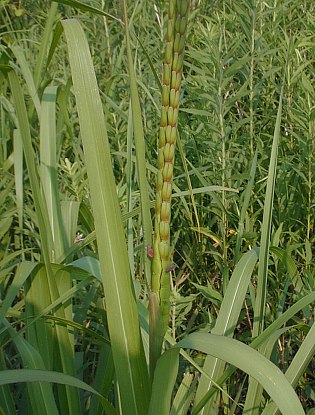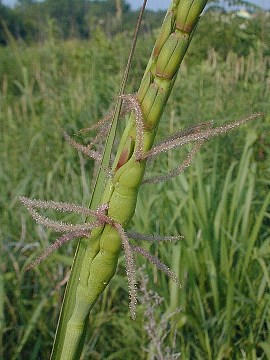 Description: This native perennial plant is about 3-7'
tall and usually unbranched; it forms a tuft of leaves and culms. These culms
are light green to pale reddish green, hairless, and round in circumference.
The alternate leaves are up to 2½' long and 1½" across, becoming
smaller as they ascend the stalk; they are light green to green, linear, and
hairless. The leaves typically arch upward near the stalk and downward toward
their tips; the larger leaves often have a white central vein that is rather
conspicuous. The culm terminates in 1-3 spikes of flowers; each spike is
narrowly cylindrical and up to 1' long. Spikelets of male flowers occur along
the upper two-thirds of each spike, while spikelets of female flowers occur
along the bottom third. The male flowers have lanceolate green scales (lemmas)
about 1/3" in length; they occur as pairs in each short spikelet. Each male
flower has 3 stamens consisting of slender white filaments and large orange
anthers. The female flowers are sunken into the central axis (rachis) of the
spike; each female flower has a hard outer scale to protect the developing
grain and it produces 2 feathery styles that are pale purple or purplish pink.
The blooming period occurs during the summer. Each female flower produces a
single large seed with a hard coat. The root system consists of fibrous roots
and rhizomes. Vegetative clumps of plants are often formed.
Description: This native perennial plant is about 3-7'
tall and usually unbranched; it forms a tuft of leaves and culms. These culms
are light green to pale reddish green, hairless, and round in circumference.
The alternate leaves are up to 2½' long and 1½" across, becoming
smaller as they ascend the stalk; they are light green to green, linear, and
hairless. The leaves typically arch upward near the stalk and downward toward
their tips; the larger leaves often have a white central vein that is rather
conspicuous. The culm terminates in 1-3 spikes of flowers; each spike is
narrowly cylindrical and up to 1' long. Spikelets of male flowers occur along
the upper two-thirds of each spike, while spikelets of female flowers occur
along the bottom third. The male flowers have lanceolate green scales (lemmas)
about 1/3" in length; they occur as pairs in each short spikelet. Each male
flower has 3 stamens consisting of slender white filaments and large orange
anthers. The female flowers are sunken into the central axis (rachis) of the
spike; each female flower has a hard outer scale to protect the developing
grain and it produces 2 feathery styles that are pale purple or purplish pink.
The blooming period occurs during the summer. Each female flower produces a
single large seed with a hard coat. The root system consists of fibrous roots
and rhizomes. Vegetative clumps of plants are often formed.
Cultivation: The preference is full to partial sun,
moist to mesic conditions, and a fertile loam or clay-loam to sustain its
robust growth. This species of grass can become large, although it is not
particularly aggressive. The seeds require moist stratification (exposure to
moisture & cool temperatures) in order to germinate; it is easier to
propagate new plants by dividing the clumps.
